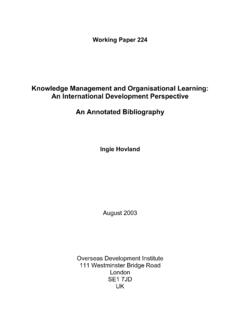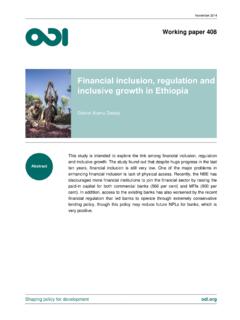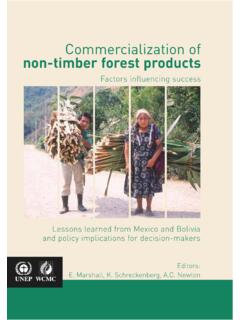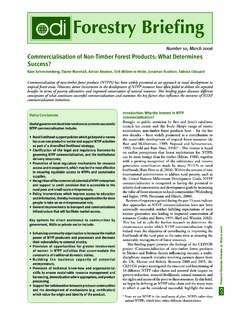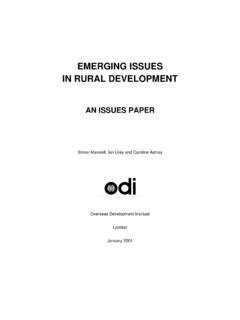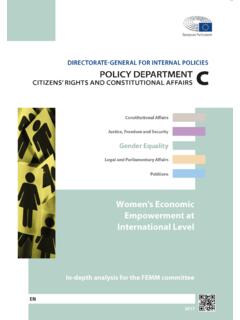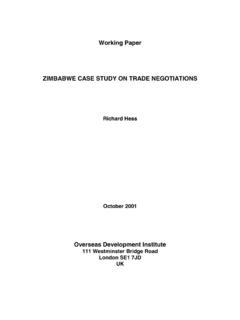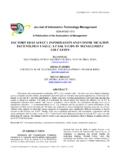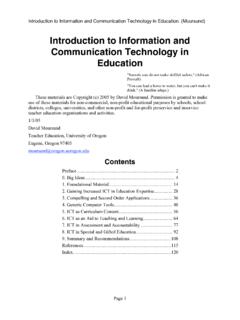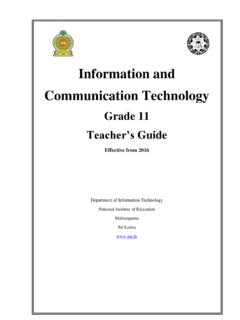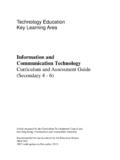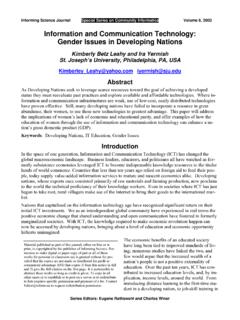Transcription of Information And Communication Technology In …
1 Agricultural Research &Extension NetworkNetwork Paper 2004 ISBN 0 85003 705 0 The Agricultural Research and Extension Network is sponsored by the UK Department for International Development (DFID)The opinions expressed in this paper do not necessarily reflect those of are happy for this material to be reproduced on a not-for-profit basis. The Network Coordinator would appreciate receiving details ofany use of this material in training, research or programme design, implementation or Coordinator: Robert Tripp Administrative Editor: Alana CoyleAbstractA study was conducted that examined the performance of three ICT projects in India. The projects have quitedifferent origins and purposes, but all are concerned with improving the delivery of Information to farmers andother rural dwellers.
2 One project is managed by the government of Madhya Pradesh as part of an exploration of e-governance. A second project is run by sugar cooperatives (with some government support) in Maharashtra andattempts to expand services to growers. The third project is an experiment by a large private agricultural inputsupplier to provide Information to farmers in Andhra Pradesh. The study describes the organisation of each project;discusses the types of farmers involved and assesses their utilisation of the services; and looks at the backgroundsand performance of the functionaries who manage the projects. The projects studied varied with respect to the typeof services provided, but these included marketing Information , extension advice, Information about ruraldevelopment programmes, and other Information from government and private findings The ICT projects provided external and on-the-job training for personnel, although there were variations withrespect to sufficient orientation towards ICT for agricultural extension.
3 All projects reviewed had younger, better educated, male farmers as their primary users, but a governmentproject in a marginal area was fairly effective at reaching poorer and illiterate clientele. In the state government project, users most valued access to market Information , land records and informationon rural development programmes. In the cooperative project, question-and-answer services, accounting, andfarm management Information were valued most. In the private company experiment, participating farmersvalued various types of Information on practices, management of pests and diseases, and rural implications ICT projects to serve resource-poor farmers require qualified and well-motivated staff to serve as an interfacewith computer systems.
4 Staff for agricultural extension projects should have adequate training in agriculture. Efforts should be made to ensure that farmers have faith in the ICT project personnel and that they are committedto the goals of the project. Before ICT projects are established in a region, rapid rural appraisals should be done to assess the type ofinformation most in demand. Government should reorient its policies in order to harness ICT s potential for contributing to AND Communication Technology INAGRICULTURAL DEVELOPMENT: A COMPARATIVE ANALYSIS OFTHREE PROJECTS FROM INDIAS haik. N. Meera, Anita Jhamtani, and RaoContact detailsDr. , Scientist, Division of Extension, Communication and Training, Central Rice Research Institute,Cuttack, India-753006, INDIA.
5 Email: (Mrs.) Anita Jhamtani, Principal Scientist, Division of Agricultural Extension, IARI, New Delhi-110012, Rao, Senior Scientist, Division of Agricultural Extension, IARI, New Delhi-110012, and Communication Technology in agricultural detailsiAcronymsiv1 INTRODUCTION1 ICT in the revival of social organisationsConvergence of ICT with agricultural developmentAreas of IT convergenceICT initiatives for agricultural development in India2 OUTLINE OF STUDY23 DESCRIPTION OF THE SELECTED PROJECTS3 Gyandoot projectWarana Wired Village projectiKisan Project4 PROCESS IMPACT5 User equity5 PROJECT STAFF6 Educational qualificationsTraining receivedOrientation towards ICT extensionProject staff s faith in peoplePersonal effectiveness6 CHARACTERISTICS OF FARMERS USING ICT SERVICES8 Exposure to mass mediaFrequency of use7 Information NEEDS OF FARMERS9 Marketing
6 InformationFacilitating access to land records/online registrationQuestion-and-answer serviceInformation about rural development programmes and subsidiesWeather forecastingLatest (best) packages of practicesPost-harvest technologyGeneral agricultural newsInformation on crop insuranceFarm business and management informationInput prices and availabilityEarly warning and management of diseases and pestsDairying and marketing of milk and milk productsAccounting and paymentSoil testing and soil sampling informationGoal commitmentCorrelates of frequency of use of Information servicesCorrelates of faith in project staff8 CONCLUSIONS13 REFERENCES14 Agricultural Research and Extension Network Paper No.
7 135ivTablesTable 1 Project training received6 Table 2 Effectiveness of functionaries7 Table 3 Correlation coefficients of project functionaries personal effectiveness8 Table 4 Regression analysis of functionaries personal effectiveness total sample8 Table 5 Distribution of respondent farmers by landholding8 Table 6 Distribution of respondents based on mass media exposure9 Table 7 Gyandoot project: farmers perception of their Information needs11 Table 8 Warana project: farmers perception of their Information needs12 Table 9iKisan project: farmers perception of their Information needs12 Table 10 Factors associated with use of IT services by farmers(specific correlations found in data analysis)12 AcronymsICTI nformation and Communication TechnologyTKDLT raditional Knowledge Digital LibrariesITKI ndigenous Technical KnowledgeNGOsNon-Governmental OrganisationsFPFF aith in Project FunctionariesBPLB elow the Poverty LineNICNETN ational Informatics Centre NetworkGISG eographical Information SystemNICN ational Informatics CentreWiLLWireless in Local Loop1 INTRODUCTIONT oday a new paradigm of agricultural development isfast emerging.
8 In both developing and developedcountries the overall development of rural areas isexpanding in new directions; old ways of deliveringimportant services to citizens are being challenged;and traditional societies are being transformed intoknowledge societies all over the report of the Task Force on India as KnowledgeSuperpower (GOI, 2001) emphasised the necessity ofdeveloping the capacity to generate, absorb,disseminate and protect knowledge and exploit it as apowerful tool to derive societal and Communication Technology (ICT) isseen as an important means of achieving such atransformation. When used as a broad tool for providinglocal farming communities with scientific knowledge,ICT heralds the formation of knowledge societies inthe rural areas of the developing world.
9 However, thiscan only be realised when knowledge and informationare effectively harvested for overall agricultural andrural development. The development of precisionfarming in countries of the North emphasisesknowledge-intensity; hence the agricultural paradigmin the developing world will have to be recast to takeadvantage of knowledge availability to achieve multiplegoals: of income, food, jobs, etc. ICT has a significantrole to perform in evolving such a paradigm, as wasevident from the Interdisciplinary Dialogue on IT:Reaching the Unreached (Swaminathan, 1993).ICT in the revival of social organisationsICT can give a new impetus to the social organisationsand productive activity of agriculture which, if nurturedeffectively, could become transformational factors.
10 The knowledge itself will become a Technology for overallagricultural development. Agricultural extension, in thecurrent scenario of a rapidly changing world, has beenrecognised as an essential mechanism for deliveringknowledge ( Information ) and advice as an input formodern farming (Jones, 1997). However it has to escapefrom the narrow mindset of transferring technologypackages to transferring knowledge or informationpackages. If this can be achieved, with the help ofICT, extension will become more diversified, moreknowledge-intensive, and more demand driven, andthus more effective in meeting farmers informationneeds. ICT has many potential applications inagricultural extension (Zijp, 1994).
